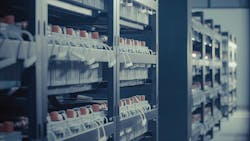Power-Outage Persistence Propels Stationary-Battery-Storage Market
What you’ll learn:
- Why is stationary-storage technology important?
- What are some recent developments in the market?
- How will the electrification of the transport sector impact the market?
Frequent power outages and the presence of conventional network infrastructure have compelled various energy companies to foray into the field of battery-storage solutions. In 2018, U.S. customers witnessed an average of nearly six hours of power failure. As a result, stationary-battery-storage systems have become popular solutions to combat pervasive power fluctuations and energy consumption.
BloombergNEF reported that almost 4 GW of new battery storage systems were globally deployed in 2018. Also, it was predicted that the count would double by 2020 if demand continued to ramp up. In line with this, the International Renewable Energy Agency estimated that a total storage capacity of up to 420 GW will be installed by the end of 2030.
Worldwide, the stationary battery storage market is on pace to reach $140 billion (USD) annually by 2030, predominantly due to favorable regulatory frameworks in accordance with the increased CO2 levels.
To illustrate, the European Union had unveiled new set of battery rules to support a sustainable energy industry. By better reflecting the technology innovations and market developments, the commission proposals take a vital step forward, putting batteries for electric mobility and stationary energy storage at its core. In fact, the new Batteries Regulation will be a key element in the implementation of the European Green Deal.
Batteries for stationary energy storage, through this initiative, are now expected to demonstrate their carbon footprint and expected to comply with a maximum carbon threshold. Along with the upcoming “Battery Passport,” the carbon intensity ratio would not only prevent underperforming batteries from debuting the EU market, but also incentivize best-in-class producers.
Claims have been made that although there are potential pitfalls with the new regulation, it’s likely to pave the way for sustainable development in the years to come. The business models and technologies underpinning advances and development of stationary-battery-storage markets are evolving rapidly. Some of these developments are outlined below.
Long-Duration Energy-Storage Opportunities
With sustainability and renewability being the buzzwords in today’s energy space, the need for low-carbon grids and long-duration energy-storage systems continues to climb. Long-duration energy storage holds immense potential in today’s power arena, especially with regard to the growing number of solar and wind power installations.
On this front, a leading developer of ultra-low-cost battery technology, Noon Energy Inc., recently secured $3 million (USD) seed funding. Through this investment, Noon’s battery is seeking to offer long-duration stationary storage at 10X lower cost than regular Li-ion batteries. With more than 100 hours of storage capacity needed, the company is set to make intermittent wind and solar power on-demand for the whole year at a cost that’s lower than fossil-fuel generation and with zero emissions.
Such developments in stationary-battery-storage systems will likely push energy industry conglomerates to take steps to gain an edge over rival companies. For instance, Form Energy, a pioneer in battery storage solutions, said it raised $ 70 million (USD) in 2020, pushing its total funding past $120 million (USD). The company aims to offer batteries that can store and supply energy for a prolonged time period.
Automotive Players
Apart from the energy industry, top manufacturers in the automotive industry also are exploring the profitability of entering the battery storage arena. For example, in June 2018, leading automaker, Hyundai announced it was teaming up with Greensmith to get a foothold in the stationary storage industry.
Overall, electrification of the transport sector could become a prominent driver for stationary-battery-storage development. Used batteries will provide a green source of income for automakers and a less expensive source for storage system development for their energy customers.
The Hyundai-Greensmith partnership is aimed at developing second-life battery products. Moreover, in unison, the companies hope to build a continuous and global supply chain encompassing battery production, stationary storage deployment, EV sales, and end-of-life recycling.
IBM, seeking to revolutionize the battery space, in December 2019 introduced a cobalt-free battery. The idea behind this move is to clear up the energy-storage supply by cleaning out the mess created by certain heavy metals and other materials commonly used in Li-ion batteries. IBM’s initiative is poised to reduce the environmental impact of producing rechargeable electronic goods as well as stationary-energy-storage systems.
